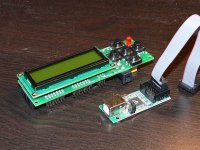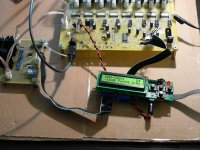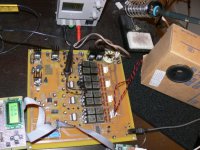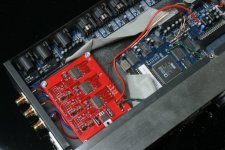Markus:
JackRabbit has I2C C libraries. Just call 1 func to access I2C.
Any Idea on source optimization is welcome. pls email me!
heater:
I'm not familier with AVR but , AVR Development STK200 +USB JTAGICE + AVR Studio + AVRGCC = $139 sounds nice.
I must need below to straight moving
(1) ICE debug
(2) LCD
(3) 6 Key
(4) I2C
(5) GPIO ( 8 bit or so )
(6) 128kB program flash
(7) 4kWord or more RAM
and optional
(6) USB for PC connection?
Do you know any good moduled board for AVR?
JackRabbit has I2C C libraries. Just call 1 func to access I2C.
Any Idea on source optimization is welcome. pls email me!
heater:
I'm not familier with AVR but , AVR Development STK200 +USB JTAGICE + AVR Studio + AVRGCC = $139 sounds nice.
I must need below to straight moving
(1) ICE debug
(2) LCD
(3) 6 Key
(4) I2C
(5) GPIO ( 8 bit or so )
(6) 128kB program flash
(7) 4kWord or more RAM
and optional
(6) USB for PC connection?
Do you know any good moduled board for AVR?
I tried to e-mail you but I get:
---------------
Sorry! That user has specified that they do not wish to receive emails through this board. If you still wish to send an email to this user, please contact the administrator and they may be able to help.
---------------
You can change it in your profile settings in the forum.
Marek
---------------
Sorry! That user has specified that they do not wish to receive emails through this board. If you still wish to send an email to this user, please contact the administrator and they may be able to help.
---------------
You can change it in your profile settings in the forum.
Marek
I was updating Code for these couple of days.
Now lines are almost half, but total ROM size are not so different.
This code controlls..
(1) CS8416 Rx Channel
(2) TAS5518 Volume
(3) External Parallel PSVC (16dB / 4bit)
(4) TAS5518 BiQuad 0,1 (LPF) 2,3 (HPF), Channel Offset, Mute
(5) TAS5518 BiQuad 5,6,7 (Peaking, Low Shelf, High Shelf)
1/3OCt point, Gain, Q
by JackRabbit and CrystalFontz Serial LCD.
Now lines are almost half, but total ROM size are not so different.
This code controlls..
(1) CS8416 Rx Channel
(2) TAS5518 Volume
(3) External Parallel PSVC (16dB / 4bit)
(4) TAS5518 BiQuad 0,1 (LPF) 2,3 (HPF), Channel Offset, Mute
(5) TAS5518 BiQuad 5,6,7 (Peaking, Low Shelf, High Shelf)
1/3OCt point, Gain, Q
by JackRabbit and CrystalFontz Serial LCD.
Attachments
Very nice. I see that you changed the Params structure. I wanted to simplify it with the union keyword but your idea with arrays of structures within a structure is even better. I assume that you added a new functionality but the size of the code is 50% of the previous code.  . I like it. I regret only that I don't have JackRabbit to see how it works. But if someone can port it to e.g. AVR (??????), this would become a great software project (OK, it's already such a project). Koon, congratulations.
. I like it. I regret only that I don't have JackRabbit to see how it works. But if someone can port it to e.g. AVR (??????), this would become a great software project (OK, it's already such a project). Koon, congratulations.
Marek
Marek
Hi Marek
Yes I added PSVC control function, and more strict parameter control.
http://microcontrollershop.com/product_info.php?products_id=588
I wonder this board can work instead of JackRabbit($49) + CS633($100).
Button is 5, so I should modify to add Save / Cancel Dialog to select save or cancel in 5 buttons. but Flash is 128K, RAM is 4K.
Anyone knows better board?
Yes I added PSVC control function, and more strict parameter control.
http://microcontrollershop.com/product_info.php?products_id=588
I wonder this board can work instead of JackRabbit($49) + CS633($100).
Button is 5, so I should modify to add Save / Cancel Dialog to select save or cancel in 5 buttons. but Flash is 128K, RAM is 4K.
Anyone knows better board?
I got ATMega128 + LCD + Keypad board today.
http://microcontrollershop.com/product_info.php?products_id=588
it will kill my holidays
http://microcontrollershop.com/product_info.php?products_id=588
it will kill my holidays
Attachments
hi Marek
http://microcontrollershop.com/product_info.php?products_id=1106
USB AVRJTAG + AVRISP for general programmer & debugger.
(not yet actually tested)
10 pin cable is included. very compact.
http://microcontrollershop.com/product_info.php?products_id=1106
USB AVRJTAG + AVRISP for general programmer & debugger.
(not yet actually tested)
10 pin cable is included. very compact.
Ported to AVR.
(1)hardware
http://microcontrollershop.com/product_info.php?products_id=588
(2)Connection
I2C: PortE, pin6 and 7
Volume Control : Port B, 7,6,5,4
Power: 12V supply from board
Peter Fleury's library are so fine, but using GCC was suffering..
It using 24KB of memory, so at least ATMega64 will be required.
(for extensibility, ATMega128 will be better)
(1)hardware
http://microcontrollershop.com/product_info.php?products_id=588
(2)Connection
I2C: PortE, pin6 and 7
Volume Control : Port B, 7,6,5,4
Power: 12V supply from board
Peter Fleury's library are so fine, but using GCC was suffering..
It using 24KB of memory, so at least ATMega64 will be required.
(for extensibility, ATMega128 will be better)
Attachments
Hi fram
control TAS5518 board over LAN ?
too much for me..
(a) I2S audio data : AVR does not have streaming interface
(b) I2C TAS5518 control (so many to make crossover)
(c) at least 4 bit GPIO for PSVC
maybe peufeu knows how difficult to make it.
http://audio.peufeu.com/
maybe AVR board with WWW server can have Crossover configuration, but software will be so huge.
control TAS5518 board over LAN ?
too much for me..
(a) I2S audio data : AVR does not have streaming interface
(b) I2C TAS5518 control (so many to make crossover)
(c) at least 4 bit GPIO for PSVC
maybe peufeu knows how difficult to make it.
http://audio.peufeu.com/
maybe AVR board with WWW server can have Crossover configuration, but software will be so huge.
You've better to use RadioShack & paper box speaker for initial amplifier testing
Yes TAS5518 can not process delay.
but I'm not serious about delay / phase, because my speaker(LINN Akurate212) or almost of market speakers originally has no delay correction. Akurate212 just using 24dB/Oct crossover(it sounds beautiful even passive), same as implemented in TAS5518.
This board has I2S jumper branch for DSP connection but I'm not so interested.
Of course PA system needs delay correction but I will not make huge speaker.
Yes TAS5518 can not process delay.
but I'm not serious about delay / phase, because my speaker(LINN Akurate212) or almost of market speakers originally has no delay correction. Akurate212 just using 24dB/Oct crossover(it sounds beautiful even passive), same as implemented in TAS5518.
This board has I2S jumper branch for DSP connection but I'm not so interested.
Of course PA system needs delay correction but I will not make huge speaker.
Believe me, delays or phase shifts are almost always required for proper on-axis summing, no matter if speakers are hi-fi or PA. Otherwise you will end up getting the sweet spot somewhere in the ceiling or the floor. They are not only required to compensate for physical driver offsets, but also for driver phase shifts, which may easily be 45 degrees near crossover region (up to 180 degrees near driver/box roll-offs). Ultimately you can achieve this by intentionally detuning the crossover frequencies (by not using the same Q and the same freq for each pole/zero of the LP and HP ends) which is how manufacturers do it in passive crossovers.
Ideal Linkwitz-Riley filters (with matched LP and HP ends) are completely useless for real speakers, but with proper detuning (or phase shifting and/or delay) they usually start to work as expected. You have to design the filter so that an ideal Linkwitz-Riley response is obtained from the speaker (after applying its own poles and zeros, not from the filter itself).
A great low-cost tool for finding optimum filter parameters is Behringer DCX2496.
I'm explaining all this because I once was an electronics freak that imagined speakers as ideal transducers and I was expecting wonders out of ideal active filters... But I had to learn a lot about speakers to start getting good active filters.
So don't rely on ideal filters, instead you should leave room for adjustable detuning (as much as allowed by your chipset) and then you have to play with detuning until polarity inversion results in gentle cancellation of the crossover region at the listening position (and the right polarity does not result in excessive summing).
Ideal Linkwitz-Riley filters (with matched LP and HP ends) are completely useless for real speakers, but with proper detuning (or phase shifting and/or delay) they usually start to work as expected. You have to design the filter so that an ideal Linkwitz-Riley response is obtained from the speaker (after applying its own poles and zeros, not from the filter itself).
A great low-cost tool for finding optimum filter parameters is Behringer DCX2496.
I'm explaining all this because I once was an electronics freak that imagined speakers as ideal transducers and I was expecting wonders out of ideal active filters... But I had to learn a lot about speakers to start getting good active filters.
So don't rely on ideal filters, instead you should leave room for adjustable detuning (as much as allowed by your chipset) and then you have to play with detuning until polarity inversion results in gentle cancellation of the crossover region at the listening position (and the right polarity does not result in excessive summing).
- Status
- This old topic is closed. If you want to reopen this topic, contact a moderator using the "Report Post" button.
- Home
- Amplifiers
- Class D
- Full Digital / CrossOver / Multi Amplifier integrated



